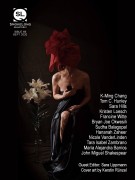“Sleepers” establishes a comedic, almost surreal atmosphere right from the jump. The characters move to another country for love (and to try a savory crepe) and land in an apartment building filled with circus performers. And yet “Sleepers” is very much rooted in reality and takes a dark turn at the end. How soon in the process of writing did you land on this tone?
The humor came first, and the darkness crystallized towards the end of the process of revision. The writing process often goes like this for me: The germ of a story arrives as a kind of joke or a piece of wordplay, and then I have to work to figure out what’s going on underneath it—what the joke is hiding, how the wordplay is functioning as a defense mechanism for the characters and/or for me. Until I identify that “subconscious” aspect of a piece and figure out how to bring it onto the page, it’s not really a satisfying story for me; it’s just some jokes.
There has been a glut of op-eds recently about how satire is dead now, and I basically agree: When the global situation is so obviously not normal—though it has never been normal—we don’t need satire’s cleverness or its exaggerations to be able to see how not-normal it is. But then, I like jokes, and I think there’s poetry in them, and this story started as one. It’s a question of who the joke is on, and ultimately, in this story, it’s on the characters. Even though I empathize with them and feel gently towards them. I wanted a tone that would capture both the genuine wonder and joy they feel in this place they don’t understand, and also how that wonder and joy is founded on misunderstanding, on that famous American obliviousness to their own position in the world.
“Sleepers” is flash fiction divided up into five parts. It’s a nifty structure and makes surprising narrative jumps through time. How did you land on this structure and how did it inform your writing?
I’ve always been drawn to numbers, sections, short and clearly delineated parcels of text. Maybe it has to do with my obsession with music, and the years I spent as a kid poring over album liner notes (R.I.P. to that…) and thinking about how the artist had divided and ordered the songs. I loved the idea of a coherent whole composed of small chunks. Lately, I’ve loved Valeria Luiselli’s Lost Children Archive, Alejandro Zambra’s Multiple Choice, and Jenny Offill’s novels for the deftness with which they achieve that effect.
A year ago, I was working on another flash piece and I saw that the five sections were nearly the same length. I thought, why not make them all exactly the same length? I wanted the sections to look the same on the page, to be in conversation with certain poems in that way. I also wanted to establish, through similarity, a set of rhythms akin to the rhythms in songs, which are so often broken down into a certain number of choruses and verses, with a certain number of bars, a certain number of beats, and so on. So, that piece became the first in a series of “3x5s” that “Sleepers” is part of. 3×5 describes the form, and it’s also a nod to the size of index cards and photographs, both perfect carriers for vignettes.
The narrator says they are focusing their energy on having “one clear thought” and having left their country of origin, their band, and their previous retail gigs, they feel unfettered enough to be able to do this. And yet at the same time their vision is clouded by love. Do they have an epiphany? Do they achieve a clear thought?
I think so, yes, but it’s not the sweet, clarion epiphany the narrator is dreaming of. As a younger person, and specifically as a relatively privileged and sheltered younger person who had read too many books, I used to feel like I was waiting around for some big revelation. I traveled to other places and other countries in the hopes that visiting them might reveal some secret to me, something that would show me how to live and how to understand things, like the artists and real adults I admired. And eventually, I did have revelations. But they were not necessarily spiritual or philosophical, and they were certainly not uniformly beautiful. Mostly, I learned how wide the world was, how little I knew, how my country had done horrible things, and how I could not separate myself from my country and my position within it, no matter how badly I wanted to.
Trump looms large in “Sleepers” despite never being named. His victory in 2016 along with the loss of M’s sweatshirt and the fountains being turned off for winter seem to signal a psychic shift—the honeymoon is over, the sweet dreams have ended. How have the past four years and the brutality of the Trump presidency impacted these characters, and you as a writer?
Well, yeah. You’ve put it well: The honeymoon is over, for these characters and for me. Like these characters, even though I am a second-generation immigrant who has always felt a certain psychological distance from the U.S., I was among the lucky few who are even afforded a honeymoon in the first place in this country, a period of relatively blissful ignorance. Though lucky is the wrong word, because it’s not lucky when the most powerful country in the world systematically obscures the horrific roots of its power from its citizens; it’s incredibly dangerous. As for these characters, I wouldn’t be surprised if they’ve come to a similar conclusion by now, but there’s always the chance they’re still up in Montreal, ordering crepes.



 The core workshop of SmokeLong Fitness is all in writing, so you can take part from anywhere at anytime. We are excited about creating a supportive, consistent and structured environment for flash writers to work on their craft in a community. We are thrilled and proud to say that our workshop participants have won, placed, or been listed in every major flash competition. Community works.
The core workshop of SmokeLong Fitness is all in writing, so you can take part from anywhere at anytime. We are excited about creating a supportive, consistent and structured environment for flash writers to work on their craft in a community. We are thrilled and proud to say that our workshop participants have won, placed, or been listed in every major flash competition. Community works.